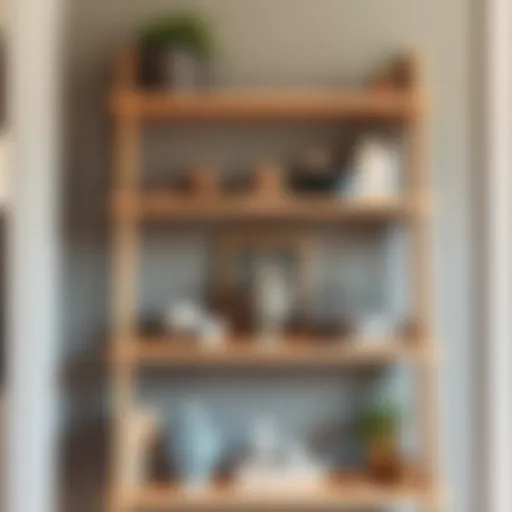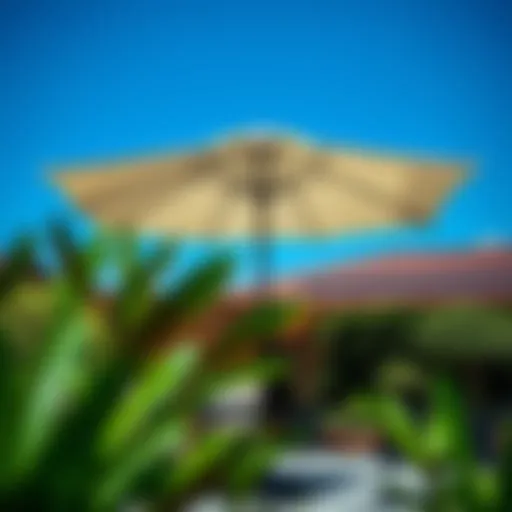Exploring 14 Inch Shelf Brackets: Function and Design Insights
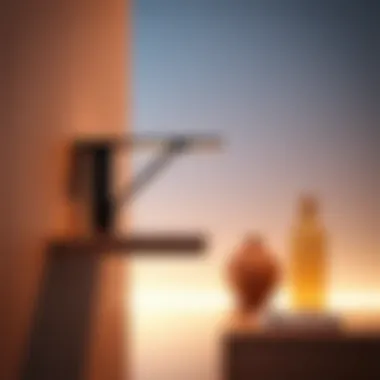
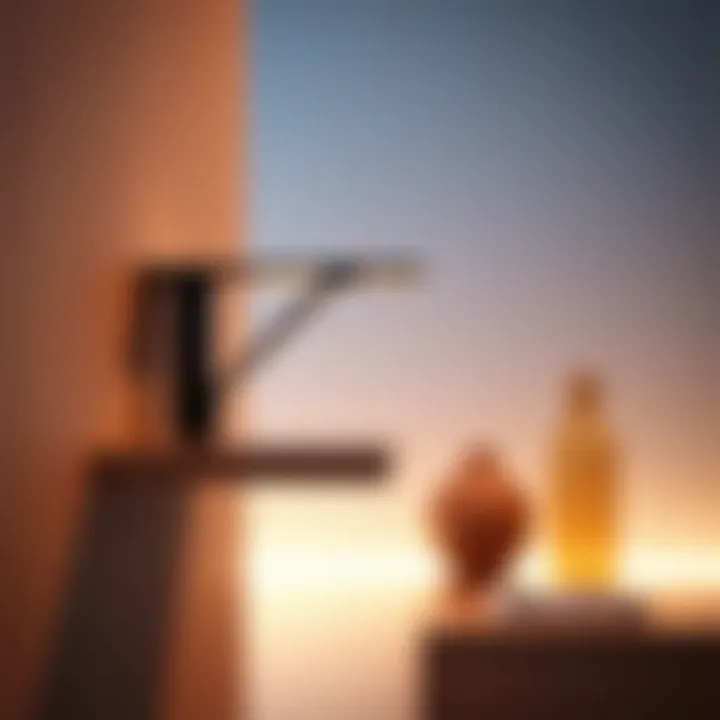
Intro
When it comes to home decor, even the smallest elements can make a significant difference. One such element that often gets overlooked is the shelf bracket. It seems simple enough, but a 14-inch shelf bracket can pull the whole room together, adding both style and usability. In this article, we'll dig into not just the practical aspects of attaching shelves to walls, but also how these brackets can elevate your design aesthetic.
You might think, "A bracket is just a bracket, right?" Wrong. The right shelf bracket has the capability to transform an ordinary wall into the focal point of the room. With various materials and designs to choose from, 14-inch shelf brackets are more versatile than they appear. Whether you seek a modern minimalistic vibe or a rustic charm, there’s a way to find a bracket that complements your decor.
In our exploration, we'll also take a look at installation techniques, ensuring you can confidently hang a shelf that not only serves its purpose but stands the test of time. We'll provide guidance on picking the right bracket, considering factors like materials and weight limits, enhancing your overall experience as a homeowner or designer.
So, let’s step into the world of shelf brackets, and see how such a humble accessory can significantly impact functionality and design in your home. But first, let’s dive into current design trends that inform how these brackets can be integrated into modern spaces.
Intro to Shelf Brackets
Shelf brackets are often overlooked elements but hold significant value in securing shelves and adding to the overall aesthetic of a space. This article delves deep into various aspects of 14-inch shelf brackets, emphasizing their functionality, design variations, and best practices for use. With the rise of DIY culture and home improvement projects, understanding shelf brackets has become more pertinent than ever.
They serve not only as support structures but also as decorative pieces that can enhance the beauty of a room. Homeowners and designers alike must recognize the importance of choosing the right brackets that align with their needs and style preferences. This foundational understanding helps in making informed decisions that can elevate the functionality and visual appeal of a home.
The right shelf bracket can seamlessly merge utility with aesthetics, transforming plain storage into a statement.
Moreover, the choice of materials and designs contributes significantly to durability and style. Exploring the historical context of shelf brackets gives insight into how their design has evolved over the years, reflecting cultural shifts and architectural trends. In a world where space optimization is crucial, especially in urban settings, knowledge about shelf brackets is essential for maximizing both utility and style in our living spaces.
Definition and Purpose
A shelf bracket, fundamentally, is a support device that is attached to a wall to hold a shelf. These brackets can vary widely in design, from simple metal brackets to intricately designed ornamental ones. Their primary purpose is to provide stability to shelves that are used for storage or display.
Homeowners must choose brackets that can safely support the weight of the items expected to be placed on the shelf. This means taking into account both the material of the bracket and its installation into the wall structure. The right bracket acts as a silent workhorse in the background, ensuring that shelves remain steadfast and functional.
Shelf brackets not only support materials but also help define a room's character. Whether it's a sleek, modern look or a rustic charm, the design choice can significantly influence the ambience.
Historical Context
Shelf brackets have a rich history that dates back to ancient civilizations. Initially, they were made from stone or wood and were often carved to reflect the artistry of the time. Over the centuries, the design evolved with advancements in technology and shifts in aesthetic preferences. In the Victorian era, for instance, ornate brackets became popular, highlighting craftsmanship and decorative style.
As industrialization took hold, the emergence of metal brackets transformed the market. These metal supports offered enhanced strength and durability, making them a practical choice for building and home use. With the advent of modern design movements, shelf brackets evolved to include minimalist and functional styles, reflecting today's functional yet aesthetic demands.
This historical perspective is critical for understanding how shelf brackets have adapted to meet the needs of various living environments, encouraging a blend of function and form that continues to thrive today.
The Advantages of Inch Shelf Brackets
14 inch shelf brackets are more than just functional hardware; they serve as an essential component in the aesthetics and utility of modern interior design. Many homeowners and designers overlook the profound impact of these supports, yet they can be a game-changer in optimizing both space and style. Here, we will explore the benefits these brackets offer, providing insights into why they deserve a place in your home.
Stability and Strength
One of the most compelling advantages of 14 inch shelf brackets is their stability and strength. The dimensions allow them to support a considerable weight, making them ideal for various applications—be it a wooden shelf filled with books or a sleek glass shelf showcasing decorative items. The durability comes often from the materials used, such as heavy-duty steel or sturdy wood, which can sustain significant loads without bending or warping.
The engineering behind these brackets ensures that they distribute weight evenly, reducing the risk of sagging or failure over time. Homeowners can enjoy peace of mind knowing their belongings are secure. This functionality is particularly crucial in spaces such as kitchens, where heavy kitchenware can quickly add up. Moreover, when properly installed, they can withstand the day-to-day rigors of family life, from kids reaching for their favorite cereal to the occasional binge-watching session with a stack of snacks.
Versatility in Design
Moving beyond stability, 14 inch shelf brackets exhibit remarkable versatility in design. They come in an array of styles that can adapt seamlessly to various interior design themes, from modern minimalist looks to rustic charm. This adaptability allows homeowners and designers alike to integrate them into existing decor or create bold new statements.
Consider the minimalist designs—clean lines and understated forms that contribute to a sense of openness in a room. On the other hand, industrial-style brackets made from wrought iron or aged metals can lend a rugged appeal, perfect for urban lofts or eclectic spaces. Whether a person is looking to make a statement or simply support a shelf, the wide availability of styles makes it easy to find a bracket that suits the personal taste.
Moreover, the finishing touches of these brackets can complement other elements in a room, such as light fixtures or furniture finishes. With colors like matte black, brushed nickel, or classic wood stains, they can either stand out or blend in, depending on the desired aesthetic. This flexibility enhances their functionality beyond mere support, transforming them into an integral design element.
In summary, the advantages of 14 inch shelf brackets lie in their ability to combine strength with stylistic versatility. Their practical application goes hand in hand with enhancing the visual harmony of any space, making them an indispensable choice for homeowners and designers striving for both utility and aesthetics. The following sections will dive further into the characteristics of these brackets, ensuring that you have the necessary insights to make informed decisions.
Materials Used in Shelf Brackets
Understanding the materials used in shelf brackets is crucial for anyone eager to enhance their home or workspace. It’s not merely about aesthetics; the choice of material influences durability, load-bearing capacity, and overall style compatibility. Whether you're a DIY enthusiast or a professional designer, grasping the strengths and weaknesses of each type of material can inform your decisions and ultimately optimize your projects. Here, we’ll peel back the layers on the main types of materials: metal, wood, and plastic or composite options.
Metal Brackets
Metal brackets are often the superheroes of the shelf bracket world. Made from steel, aluminum, or cast iron, they bring robust strength to the table. Their hardiness allows them to support a considerable amount of weight, making them ideal for heavy-duty shelving needs. In terms of design, metal brackets can lean towards the minimalist or industrial—think sleek and modern versus raw and rugged—depending on their finish.
Benefits of Metal Brackets:
- Strength: They handle considerable weight loads, making them perfect for books or kitchenware.
- Durability: Resistant to bending and rust, especially those treated for corrosion resistance.
- Design Flexibility: Available in various styles, from sleek to ornate.
Considerations: While metal brackets are strong, they can be more cumbersome to install, especially in spaces with stud configurations that don't align perfectly with the bracket. Also, certain designs might clash with softer decor themes. Metal brackets generally fit more with contemporary settings rather than rustic or vintage styles.
Wood Brackets
Wood brackets bring warmth and character to a space that metal simply cannot match. Available in various woods—like oak, pine, or walnut—these brackets can easily complement traditional and rustic decors. Their natural beauty makes them the go-to choice for display shelving in living rooms or kitchens where aesthetics matter.
Benefits of Wood Brackets:
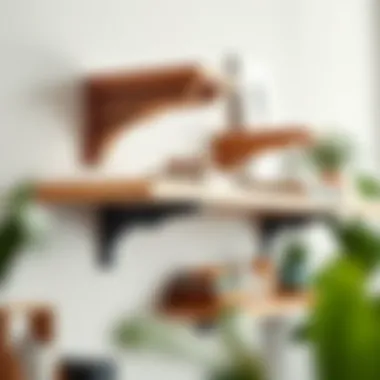
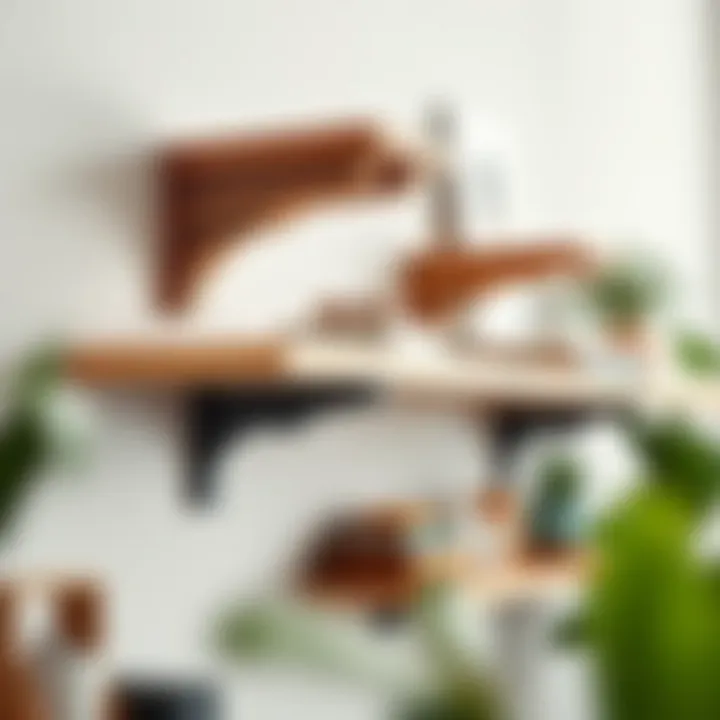
- Aesthetic Appeal: They offer a natural look that brings warmth to spaces.
- Versatility: Can be stained or painted to match any interior design theme.
- Stability: While they may not match metal in strength, high-quality wood can carry a meaningful load.
Considerations: Wood can be sensitive to humidity, which could lead to warping over time. Installation also requires careful consideration of how the brackets will attach to the wall, as they depend heavily on secure placement.
Plastic and Composite Materials
Plastic and composite brackets, though often dismissed as less durable, have their strengths. Made from materials like high-density polyethylene or fiberglass, these brackets can provide a unique blend of durability and lightweight characteristics. They are great for installations where weight is a concern or in areas prone to moisture, as they can resist corrosion and are typically impervious to water damage.
Benefits of Plastic and Composite Materials:
- Lightweight: Easy to handle and install, making them a favorite for DIY projects.
- Corrosion Resistant: Ideal for areas with humidity, such as bathrooms or kitchens.
- Cost-Effective: Generally more affordable than their metal and wood counterparts.
Considerations: While they can handle lighter loads, they may not compete with metal or even high-quality wood when it comes to weight-bearing capacity. Design options can also be more limited, often skewing toward functional rather than aesthetic appeal.
"Choosing the right material for shelf brackets is essential in ensuring they fulfill both a structural and a stylistic role in your space."
In summary, the material choice for 14-inch shelf brackets can make all the difference in ensuring your shelves are both functional and aesthetically pleasing. By understanding the implications of each material type, you can tailor your selections to not only meet your practical needs but also enhance your overall design vision.
DesignStyles of Inch Brackets
When discussing 14-inch shelf brackets, the design styles play a pivotal role in both functionality and aesthetics. The right design choice not only supports your shelves but also complements or enhances your interior decor. A well-selected bracket can bring together various elements in a room, making the space feel cohesive and thoughtfully arranged.
Minimalist Designs
Minimalism is all about simplicity and effectiveness. In the context of shelf brackets, minimalist designs strip away unnecessary elements, focusing instead on sleek lines and unembellished forms. These brackets typically feature a straightforward construction, made from materials like stainless steel or powder-coated metal.
Benefits of Minimalist Brackets:
- Visual Space: Their unobtrusive nature allows them to blend seamlessly with any background, giving a clean appearance without overwhelming the surrounding decor.
- Versatile Application: They can fit into various styles, from contemporary to Scandinavian, providing a neutral base for various shelves.
- Ease of Maintenance: With their straightforward design, cleaning and upkeep require little effort, making them an ideal choice for busy households.
Some popular minimalist brands to consider are:
- Floating Shelf Brackets by EconoHome
- Heavy Duty Brackets from The Home Depot
- L-shaped brackets by Astar
Industrial Options
Industrial designs tap into a raw, utilitarian aesthetic, often featuring materials such as aged metals, exposed bolts, and distressed wood. These brackets not only serve the practical purpose of supporting shelves but also act as decorative statement pieces that embody an edgy, robust look.
Considerations for Industrial Brackets:
- Material Durability: Made typically from iron or steel, industrial brackets withstand heavier loads, making them an excellent choice for robust shelving units in kitchens or garages.
- Character and Authenticity: The rugged look evokes a sense of authenticity and often tells a story of vintage or reclaimed materials, aligning well with eco-conscious design trends.
- Compatibility with Other Styles: Industrial brackets pair well with various materials and themes, including modern, rustic, or even farmhouse designs, allowing for flexibility in decor.
Ornamental Brackets
Ornamental brackets take the design game up a notch, adding intricate details and decorative flourishes that can transform a simple shelf into a focal point. Made often from carved wood or wrought iron, these brackets feature elaborate patterns, curves, and sometimes even motifs that reflect personal style or historical influences.
Benefits of Ornamental Brackets:
- Visual Drama: Their showy presence can elevate a room's overall aesthetic, contributing to a sense of luxury or charm.
- Artistic Expression: Homeowners looking to showcase unique tastes can opt for bespoke designs or artisan-crafted pieces that set their space apart.
- Architectural Harmony: When used in traditional or eclectic settings, ornamental brackets can harmonize with other architectural elements within the room, such as crown molding or window trim.
Information and tips about these styles can also be gleaned from websites such as Wikipedia and the American Institute of Architects.
Installation Techniques for Inch Brackets
Installing shelf brackets may seem like a simple task, but getting it right can make all the difference between a sturdy shelf and one that sags under pressure. Understanding proper installation techniques for 14 inch brackets is essential not only for functionality but also for optimizing space and aesthetics in your home.
Tools Required
Before you go diving into the installation process, it's crucial to gather the right tools. Having everything on hand will save time and frustration. Here's a list of tools you’ll need for a successful installation:
- Drill: For making precise holes in your wall.
- Screwdriver: Either a manual one or a power screwdriver will do.
- Level: To ensure your brackets are straight.
- Tape Measure: For measuring distances accurately.
- Pencil: For marking out your installation points.
- Anchor Screws: If you're installing on drywall or hollow wall, these are essential for stability.
Having these tools ready means you won’t have to run back and forth to your tool shed, keeping your momentum going.
Step-by-Step Guide
A step-by-step approach helps ensure that you don’t overlook any crucial details. Here’s a straightforward guide to installing your 14 inch shelf brackets:
- Choose Your Location: Decide where you want your shelf. Make sure it’s a sensible spot that aligns with your room's design.
- Mark the Wall: Use the tape measure to find the desired height and mark it with a pencil.
- Position the Bracket: Hold the bracket against the wall and use your level to make sure it’s straight before marking the drill points.
- Drill Holes: With your drill, create holes where you marked. If you’re using anchor screws, drill appropriately to fit them.
- Insert Anchors: For added strength, insert your anchors before attaching the brackets. These will distribute weight and prevent the bracket from pulling out.
- Attach the Bracket: Use screws to secure the brackets to the wall. Make sure they are tight but don’t over-tighten; you don’t want to strip the screws.
- Repeat for Additional Brackets: If your shelf needs more than one bracket, repeat the process for each.
- Install the Shelf: Lay the shelf onto the brackets and make any adjustments as necessary for stability.
Common Mistakes to Avoid
Even the best laid plans can go slightly off track without attention to detail. Here are some pitfalls to look out for:
- Ignoring Wall Type: Not all walls are created equal. Make sure you know what kind of wall you’re working with—studs, drywall, or masonry? Each requires different handling and tools.
- Neglecting to Check Level: A quick glance might lead to a crooked shelf. Always double-check with a level before securing everything.
- Overloading the Shelf: Even though it’s 14 inches, don’t assume it can support whatever you throw on it. Be aware of weight limits based on the bracket material and installation method.
- Skipping Anchoring: If you’re not utilizing anchors on drywall, you ask for trouble. They ensure that your brackets have the supporting strength they need.
Remember, taking the time to follow these steps and avoid common oversights can save you a lot of headaches down the road. A well-installed bracket not only looks good but also keeps your space tidy and organized.


By following these guidelines, you will create a functional and aesthetically pleasing storage solution using 14 inch shelf brackets.
Choosing the Right Size and Style
When it comes to shelf brackets, the right size and style can make or break not just the functionality but also the aesthetic of your space. It's an art and a science, where each element needs to align with the rest of your decor and practical needs. Getting this right ensures that your shelves not only hold what's needed but do so with elegance, adding a touch of personality to your room.
This section will tackle how to assess your shelf needs and how to match your brackets with interior design themes, leading to decision-making that is informed, practical, and visually pleasing.
Assessing Your Shelf Needs
Understanding your specific shelf needs is akin to knowing your audience before a presentation. You wouldn't wing it without knowing who is in the room, right? Thus, assessing the size, weight, and purpose of the shelves you plan to install becomes imperative.
- Load Capacity: Are you planning to store books, decor, or heavy appliances? Each shelf comes with a specified load limit; exceeding this could result in disaster. Make sure to check the weight ratings of the brackets, as not all of them are built the same.
- Shelf Depth and Length: A 14-inch bracket accommodates shelves that may vary in depth or length. So, it’s important to consider how far out from the wall your shelves will extend. A deep shelf requires a sturdier bracket, and vice versa.
- Location: Where will these shelves be installed? A lightweight bracket may do if it's for a small kitchen herb shelf, but a garage shelf to hold tools? That’s a different ball game altogether. Knowing the environment will guide you toward the most suitable options.
By carefully weighing these factors, you can select the appropriate size and ensure your shelves are both functional and secure.
Matching with Interior Design Themes
Design isn't merely paint and furniture; it's the harmony among all elements present. 14-inch shelf brackets offer an immense variety of styles that can complement or clash with your home's aesthetic. So the question then becomes, how do you find that perfect match?
- Modern Minimalism: If you’re leaning toward a modern feel, go for sleek metal brackets with a matte finish. They create a clean line while keeping your space uncluttered.
- Rustic Charm: Wood brackets, especially those with a reclaimed look, can add warmth and character to a rustic or farmhouse-style setting. You might also consider color variations that align with the wood textures already present in the room.
- Industrial Edge: Exposed hardware is very much on trend, especially in urban lofts. Using wrought iron or aged brackets can add an industrial vibe, balancing raw textures with modern decor.
Keep in mind; even the most functional bracket can be a visual burden if it doesn’t fit the design narrative of your space.
By understanding your interior design themes and how shelf brackets can enhance or detract from them, you can make choices that marry utility and beauty effortlessly. Finding that balance will elevate the look and feel of your home.
Maintenance and Care for Shelf Brackets
Maintaining and caring for shelf brackets is not just a chore; it is an essential part of ensuring their longevity and functionality. These brackets support more than just shelves; they hold valuable items, decor, and sometimes even your cherished memories. A bit of regular attention can prevent significant issues down the road, saving you time and money while keeping your space looking sharp.
Cleaning and Preservation
Keeping your shelf brackets clean isn’t just about appearance, it ensures they function optimally. Dust and grime can build up, affecting materials over time. For metal brackets, a simple mixture of warm soapy water and a soft cloth can do wonders. Gently scrub to remove any stubborn spots, then rinse with a damp cloth to eliminate any soap residue.
When it comes to wooden brackets, they can require a bit more finesse. You might opt for a specialized wood cleaner to preserve their finish and grain. Avoid soaking them, as too much water can cause warping. Instead, lightly dampen a cloth and wipe down.
Another tip to keep in mind: regular inspections can help catch issues early. If you notice any rust on your metal brackets or paint peeling on wooden ones, it's better to address these concerns sooner rather than later. A quick touch-up can go a long way, helping maintain both aesthetics and structural integrity.
"The ongoing care of shelf brackets can extend their life and maintain their sturdy hold, which is essential in any home."
Repairing Damage
Despite the best care, accidents happen. It could be as simple as a heavy item shifting unexpectedly or a little too much force applied during cleaning. Knowing how to repair damage to shelf brackets is essential for every homeowner or DIY enthusiast.
For metal brackets, any small dents can often be resolved with a hammer and a wooden block. Place the block against the dent and gently tap back into shape. For rust, sand it down gently and apply a rust-inhibiting paint or sealant to protect against future issues.
Wooden brackets can be trickier. If you encounter cracks or chips, wood glue may be your lifesaver. Apply it liberally to the damaged area, clamp it for a while, and then sand it down once it’s dry. For larger damage, like a broken bracket, you might need to reassess and replace.
Additionally, it is important to tighten screws and bolts regularly to ensure stability. Loose fittings are one of the leading causes of shelf failures. A simple wrench or screwdriver is often all you need to keep things secure. Regular upkeep not only keeps your brackets looking their best but also keeps your shelves ready for whatever you want to place on them.
The Role of Shelf Brackets in Space Optimization
In today’s fast-paced living environments, where square footage often comes at a premium, the role of shelf brackets extends well beyond mere support. These unassuming components can be the unsung heroes of efficiency, transforming vertical space into valuable storage and display areas. When strategically utilized, 14-inch shelf brackets are a game-changer for both homeowners and designers, offering a smart solution to space limitations while simultaneously enhancing the overall aesthetics of a room.
Effective use of shelf brackets allows you to take advantage of height—one of the most underutilized dimensions in many homes. Instead of cluttering the floor with bulky furniture or cramming items into cabinets, you can create stunning displays in the air, adding visual intrigue and functionality. Whether you're a DIY enthusiast or a professional designer, understanding the potential of shelf brackets can drastically improve your space’s usability and charm.
"A well-placed shelf can breathe new life into a room, pulling everything together like a cherry atop a sundae."
Maximizing Vertical Space
Maximizing vertical space is about more than just storing items out of the way; it’s about bringing order and accessibility into your life. For instance, the use of 14-inch shelf brackets enables you to install shelves at various heights along a wall. This means you could place an assortment of books, decorative pieces, or even plants in ways that draw the eye upward, creating a sense of expansion. Within small apartments or studios, this vertical emphasis can make the space feel less cramped and more inviting.
Consider the following:
- Layering Effect: Incorporating shelves in staggered or layered arrangements can create visual depth. By positioning brackets carefully, you can give the impression of a larger space while simultaneously showcasing your design flair.
- Open Floor Plans: In a world where open-concept living is increasingly popular, the 14-inch bracket can help define spaces without obstructing movement. They can hold shelves that display personal collections, delineating areas like a living space from a dining area without using physical barriers.
- Functional Heights: It’s crucial to think about the heights at which shelves are mounted. Lower shelves are perfect for frequently used items, while higher ones can be reserved for aesthetic artifacts or seasonal decorations.
Enhancing Functional Areas
Shelf brackets, when used wisely, can enhance specific functional areas of your home. Think about how often certain spaces are used and how a strategic placement of shelves can improve their dynamic. For example, in kitchens, a 14-inch shelf can hold spices, cookbooks, or even decorative plant arrangements, freeing up counter space while making items readily accessible. Similarly, in home offices, they provide a perfect platform for books or office supplies, keeping the workspace organized and promoting productivity.
Some practical ideas include:
- Living Rooms: Position shelves above sofas or TV units to display decorative items without consuming floor space. A well-placed shelf can create a focal point that draws attention.
- Bathrooms: Use brackets to install shelves for toiletries and linens, turning often wasted wall space into functional storage that keeps necessities within easy reach.
- Entryway: A shelf by the front door can hold keys and mail, serving as a catch-all that keeps your entryway tidy.
Comparative Analysis of Leading Brands
When it comes to selecting 14 inch shelf brackets, understanding the variety of options available can make all the difference. This section aims to shed light on some leading brands and what makes each one stand out in terms of quality, style, and functionality. For the discerning homeowner, designer, or DIY enthusiast, grasping the nuances between these brands can lead to a more informed purchasing decision and ultimately a better fit for their specific needs.

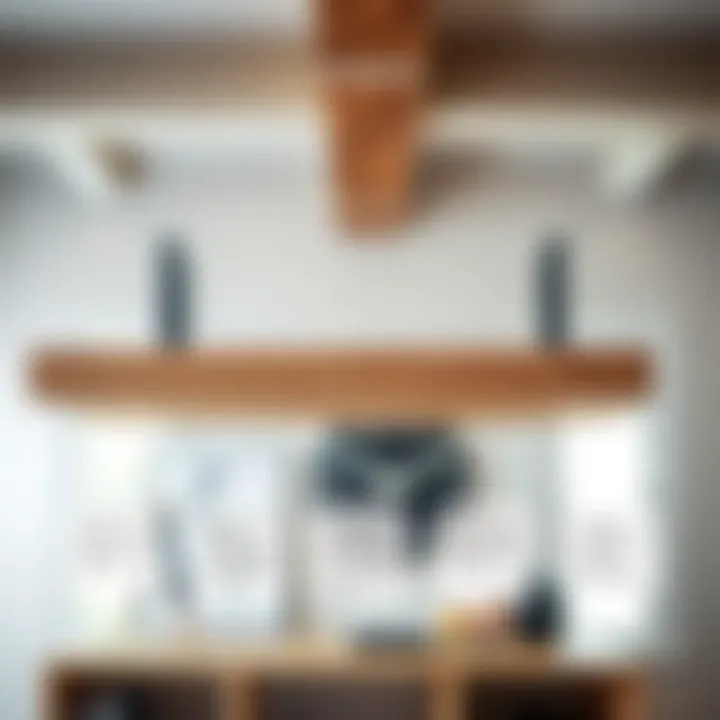
Brand A Overview
Brand A, known as HeavyDuty Support, has made a name for itself for durability and strength. Their brackets are typically constructed from high-grade steel, which ensures that they can bear substantial weight without any sign of sagging.
- Key Features:
- Weight Capacity: Up to 150 lbs per pair
- Available Finishes: Matte black, brushed nickel, and white
- Installation Ease: Comes with all necessary mounting hardware
Additionally, HeavyDuty Support is praised for its straightforward installation process. Users often mention that the provided instructions are clear and that the hardware included is ample—saving them that annoying trip to the hardware store. The company often emphasizes sustainability in their manufacturing process, using recycled materials and providing a warranty that adds an additional layer of assurance.
Brand B Overview
Moving to Brand B, known as RusticCharm, this brand leans into aesthetic design as much as functionality. Their shelf brackets exude a vintage appeal, often made from wrought iron or wood, appealing to those who prioritize style alongside strength.
- Key Features:
- Aesthetic Options: Ornate designs and rustic finishes
- Environmental Impact: Sourcing from sustainable wood
- Size Variety: Multiple designs catering to different decor styles
For those looking to add a touch of tradition or character to their space, RusticCharm usually checks off all the boxes. Customers rave about their unique finishes and craftsmanship. However, it’s worth noting that their brackets may handle less weight compared to metal counterparts, so keeping that in mind is essential for heavy-duty applications.
Brand Overview
Lastly, we have Brand C, which goes by the name of FlexiBrackets. This brand shines when it comes to customizable solutions, often providing adjustable brackets that can fit shelves of varying depths.
- Key Features:
- Adjustable Design: Can modify height and width according to shelf size
- Build Quality: Composed of a robust composite material
- User Feedback: High ratings for versatility and ease of use
FlexiBrackets is particularly popular among renters or those who like to change their decor frequently without committing to one style. The adaptability of their brackets helps ensure users don't end up with mismatched aesthetics or sizes in the long haul. Brand C has also been noted for their reliability, often mentioned in reviews for lasting a long time even after multiple adjustments.
"Choosing the right bracket isn’t just about looking good; it’s about getting the job done right. Each brand brings something unique to the table, making it crucial to weigh your options carefully."
The comparative analysis of these brands lays out the landscape quite well. While HeavyDuty Support focuses on sturdy, reliable brackets ideal for serious loads, RusticCharm pleases those with an eye for design, and FlexiBrackets caters to the adaptable user. As you consider your options, take the time to match the brand's strengths with your specific needs to ensure the results meet expectations.
The Environmental Impact of Shelf Brackets
Shelf brackets, while often considered mere accessories for support, carry weighty implications for our environment. The production and usage of these seemingly innocuous items can influence everything from resource consumption to waste generation. In this section, we will peel back the layers on how shelf brackets, specifically the 14-inch variety, can be made more eco-friendly and the importance of mindful material choices and ethical production practices.
Sustainable Materials
When discussing the environmental footprint of shelf brackets, materials take center stage. Sustainable materials refer to resources that can be sourced or produced without depleting ecological processes or causing significant harm to the environment. Today, several manufacturers are adopting more responsible practices.
- Recycled Metals: Using recycled steel or aluminum instead of virgin materials cuts down on mining and reduces energy consumption. Not only does this approach help the environment, but it often results in cost savings as well. Custom brackets fabricated from upcycled materials can offer robust support while embracing sustainability.
- Renewable Resources: Brackets fashioned from bamboo, for instance, are gaining traction. Bamboo is fast-growing and can be harvested sustainably. It’s a viable alternative that supports both strength and an eco-conscious image for your home.
- Bioplastics: Some innovative brands are experimenting with bioplastics derived from plants. These materials are designed to break down naturally over time, rather than contributing to the oceans of plastic waste suffocating our environment.
To truly consider the impact on our planet, it’s pivotal to investigate the origin of materials used in shelf brackets. Looking for certifications, such as the Forest Stewardship Council (FSC) for wood products, can be reassuring when aiming for sustainable choices.
"Opting for eco-conscious materials is not just a trendy choice; it's a tangible step towards a greener future."
Ethical Production Practices
Alongside material choices, the ethical production of shelf brackets has become a significant talking point in design circles. It encompasses everything from factory conditions to labor practices. Here's what to keep in mind:
- Fair Labor Standards: Purchasing products made in facilities that treat workers well can create a ripple effect in promoting humane working conditions around the globe. Brands that are transparent about their labor practices are often more trustworthy.
- Local Manufacturing: Sourcing brackets made locally not only reduces the carbon footprint associated with transportation, it can also support community economies. Choosing local often means better quality and shorter supply chains, which can mitigate exploitation.
- Responsible Waste Management: Some manufacturers are turning the tide by implementing practices that minimize waste during production. Utilizing every part of material and reducing excess can have lasting benefits for the planet.
In essence, as consumers, being conscious of how the shelf brackets we choose impact the environment can transform our purchasing habits. It no longer needs to be just about functionality or aesthetics, but also about being stewards of our planet, making informed choices that echo far beyond our homes.
Future Trends in Shelf Bracket Design
Understanding the future trends in shelf bracket design is crucial for homeowners, designers, and retailers alike. As design norms evolve alongside technology and sustainability concerns, it becomes imperative to adapt to these changes. This section highlights several critical elements that are driving innovation within the shelf bracket domain. Adaptation not only enhances usability but also ensures aesthetic consistency within modern interiors, paving the way for a more cohesive design narrative.
Innovation in Materials
The materials used in shelf brackets have seen remarkable advancements. Gone are the days when sturdy meant heavy steel or outdated woods. Now, we observe a shift towards lightweight yet durable composites, including materials like fiberglass and reinforced plastics.
- Benefits of Advanced Materials:
- Lightweight: This change facilitates easier installation and reduces the wear and tear on walls.
- Durability: Composite materials can resist moisture and temperature fluctuations, making them ideal for diverse environments.
- Design Flexibility: New materials can be molded into intricate designs, granting designers the freedom to push boundaries in aesthetics.
For example, some modern brackets are crafted from a special aluminum alloy that combines exceptional strength with a sleek look. The innovation in material science doesn’t merely enhance functionality; it allows for a plethora of designs from minimalist to intricate, making it easier for consumers to find a bracket that resonates with their style.
"The trends in material innovation reflect a broader vision of sustainability and creativity in furniture design."
Integration with Smart Homes
As technology becomes increasingly integrated into the fabric of our living spaces, smart home compatibility also extends to shelf brackets. Innovative brands are working on designs that can incorporate features like adjustable heights or built-in LED lighting. This isn't just a fanciful notion; it has practical implications.
- Considerations:
- Functionality: Adjustable brackets allow homeowners to easily modify their shelving setups, adapting to changes in decor or need.
- Lighting Options: The integration of LED lights into brackets can serve both functional and aesthetic purposes, illuminating shelves in an elegant way.
- Connection with Home Networks: Imagine shelf brackets with sensors that notify users if a shelf is overloaded, linking to a smartphone app.
The rise of smart home products illustrates a growing expectation for furniture and accessories to not only look good but also enhance daily living through integrated technology. As customization becomes more prevalent, the smarter designs of shelf brackets will likely play a pivotal role in how we utilize our walls and spaces.
In summary, understanding these future trends in shelf bracket design helps consumers, designers, and retailers stay one step ahead. Embracing innovation in materials and technology not only meets the demands of modern living but also aligns with sustainability goals, making our environments better, smarter, and more stylish.









